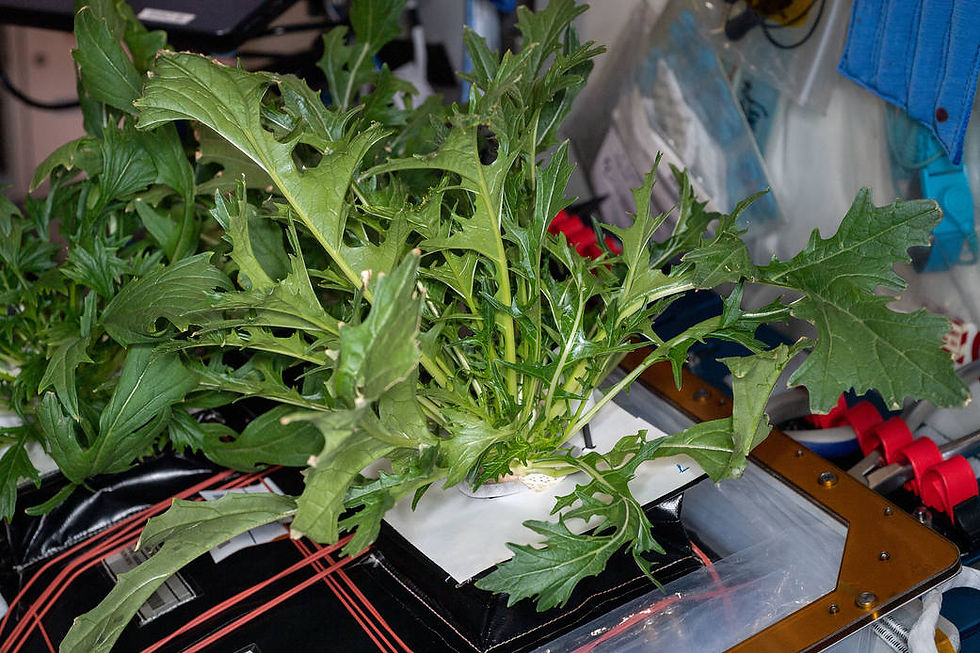Growing plants and crops in space or other extraterrestrial conditions is referred to as Space Farming, also known as Space Agriculture or Astroculture. In simple terms, it refers to the farming of plants for food and other materials in space, which is similar to agriculture on the moon.

Image source: https://images.app.goo.gl/UW8YWwDaSCyLwUdS8
For long-duration space missions, like colonization initiatives, it is a crucial area of research and development since it intends to give astronauts access to fresh food, oxygen, and the psychological advantages of interacting with plant life.
Due to the critical conditions that encountered in space, such as microgravity, scarce supplies, harmful radiation, extremely high temperatures, and the absence of air pressure, space farming presents a number of difficulties. However, many methods and systems for growing plants in space have been developed due to advances in science and technology.
On the space station is a space garden called Veggie, or the Vegetable Production System. The goal of Veggie is to aid NASA in its study of plant development in microgravity while also improving astronauts' happiness and well-being aboard the orbiting laboratory by providing them with fresh meals. Usually holding six plants, the vegetable garden is about the size of a carry-on bag. Each plant develops in a "pillow" that contains fertilizer and a growth medium made of clay. Three different kinds of lettuce, Chinese cabbage, mizuna mustard, red Russian kale, and zinnia flowers have all been successfully cultivated by Veggie so far.

NASA astronaut Scott Tingle tends to plants grown inside the VEGGIE facility in support of space botany research. Image source: NASA Image gallery
Like Veggie, the Advanced Plant Habitat (APH) is a growth chamber on station for studying plants. To get water, nutrients, and oxygen to the plant roots, it uses LED lights and a porous clay substrate with controlled release fertilizer. Contrary to Veggie, it is contained and automated with cameras and more than 180 sensors that are in continual interactive contact with a team at Kennedy, so the crew doesn't have to give it much attention on a daily basis.

Four pepper plants growing in the Advanced Plant Habitat (APH) aboard the International Space Station that have sprouted several flowers. Image source: NASA Image gallery
Did you know that astronauts are known to experience head stiffness in microgravity? As a result, spicy foods are frequently included on the menu to encourage astronauts to consume meals. According to NASA, this pepper variation, also known as the NuMex "Espaola Improved" pepper (a hybrid Hatch pepper), naturally thrives in places like New Mexico. Researchers spent two years deciding between two dozen kinds before selecting this one for a space voyage because of its potential for feeding people on missions further from Earth.
Space farming's main components are as follows:
Technologies for Plant development: A variety of technologies have been developed to support plant development in space. One popular method is hydroponics, in which plants are cultivated in nutrient-rich water solutions instead of soil. Another technique that grows plants in an atmosphere of air or mist while feeding the roots with nutritional solutions is called aeroponics. These techniques reduce the requirement for soil and increase resource effectiveness.
Regulated Environment: To provide the ideal circumstances for plant growth, space farming depends on extremely regulated settings. This involves managing the temperature, humidity, brightness, and carbon dioxide concentrations. As natural sunshine is scarce or non-existent in space, LED lighting systems are frequently employed to produce particular light wavelengths for photosynthesis.
Management of Water and Nutrients: Since water is a limited resource in space, effective water management is essential. Systems for recycling water are used to reduce waste and provide a sustainable supply. Additionally, nutrient management is essential to provide plants the building blocks they need to flourish. To maximize resource consumption, closed-loop nutrient cycles are employed.

Plant harvest from the Veggie production facility for the Veg-04A experiment, part of a series of fresh food experiments that includes HRF Veg. Image source: NASA Image gallery
Crop Selection: Not all plants can be grown in space. When choosing crops, certain factors are taken into account, including nutritive value, growth rate, water and fertilizer needs, and resilience to environmental stressors. Wheat, lettuce, radishes, mizuna, mustard greens, and other plants are frequently produced in space.
Space gardening: It assists astronauts psychologically in addition to supplying them with food and oxygen. Air quality, mood, and a sense of connectedness to nature can all be enhanced by the presence of plants. Astronauts frequently participate in the cultivation process, caring for the plants, observing their development, and gathering the harvest.
Research and Experiments: To improve our comprehension of plant development in space and create more effective farming techniques, space agencies and research institutions carry out experiments. These studies of the impact of microgravity on plant biology and the optimization of space farming methods have been made possible thanks to the International Space Station (ISS).
Establishing self-sustaining agriculture systems in space is the ultimate aim of space farming in order to support long-duration missions and possible human colonization of other celestial bodies. In addition to addressing the practical challenges of feeding astronauts, it advances our knowledge of plant biology, distribution of resources, and life support systems in harsh conditions.
We will dive deeper into space food and space food systems in forthcoming posts. So stay updated..



Comments